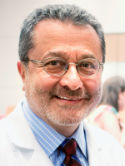Total body irradiation for bone marrow transplantation: The Memorial Sloan-Kettering Cancer Center experience Conference Paper
| Authors: | Shank, B.; O'Reilly, R. J.; Cunningham, I.; Kernan, N.; Yaholom, J.; Brochstein, J.; Castro-Malaspina, H.; Kutcher, G. J.; Mohan, R.; Bonfiglio, P. |
| Title: | Total body irradiation for bone marrow transplantation: The Memorial Sloan-Kettering Cancer Center experience |
| Conference Title: | International Meeting on Physical, Biological and Clinical Aspects of Total Body Irradiation organised under the auspices of ESTRO, EULEP and EBMT |
| Abstract: | In May 1979, Memorial Sloan-Kettering embarked on a programme of hyperfractionated TBI (HFTBI), 1320 cGy in 11 fractions over 4 days with partial lung shielding (1 HVL), followed by cyclophosphamide (60 mg/kg/d × 2d) for cytoreduction prior to allogeneic bone marrow transplantation (BMT). Anterior and posterior chest wall electron "boosts" were given to the areas blocked (600 cGy in 2 fractions) on the last two days of treatment. Since then, we have treated over 600 patients with HFTBI, the majority for allogeneic BMT. Several modifications have occurred over the years. We have added a "boost" electron dose of 400 cGy to the testes in all male leukemic patients; this reduced testicular relapses from a rate of 14% (4/28) to 0%. In an attempt to increase engraftment of T-depleted BMTs, we added one additional fraction; since our present dose/fraction was also increased to 125 cGy, we now deliver a total dose of 1500 cGy in 12 fractions over 4 days for allogeneic transplants. Tolerance to HFTBI has been excellent relative to the single dose (SD) regimen utilised prior to May, 1979. The incidence of fatal interstitial pneumonitis (IP) decreased from 50% in the SD regimen to 18% after the introduction of HFTBI. In children, the incidence of IP was only 4% with HFTBI. With the introduction of T-depleted marrows, fatal IP in adults has decreased also, e.g. to < 10% in CML patients. With conventional BMT after HFTBI, relapse at 5 years has been exceedingly low (e.g. in children, 13% for ALL, 2nd remission and 0% for AML, 1st remission) and engraftment has been 100%. With matched T-depleted BMT, rejections have occurred in 15% overall; the incidence of graft failure has not been reduced by the higher dose of HFTBI. Relapses in this setting are equivalent to relapses with conventional BMT for AML, but appear to be increased for ALL. Radiobiological findings related to HFTBI will also be discussed. © 1990. |
| Keywords: | leukemia; hepatitis; multimodality cancer therapy; radiation dose; combined modality therapy; methodology; radiotherapy dosage; relapse; recurrence; cyclophosphamide; clinical protocol; radiation exposure; engraftment; whole body radiation; clinical protocols; recurrent disease; graft survival; bone marrow transplantation; lymphocyte; lymphocytes; lung fibrosis; pulmonary fibrosis; granulocyte; whole-body irradiation; interstitial pneumonitis; total body irradiation; granulocytes; human; male; female; article |
| Journal Title | Radiotherapy and Oncology |
| Volume: | 18 |
| Issue: | Suppl. 1 |
| Conference Dates: | 1988 Sep 7-9 |
| Conference Location: | Hague, Netherlands |
| ISBN: | 0167-8140 |
| Publisher: | Elsevier Inc. |
| Date Published: | 1990-01-01 |
| Start Page: | 68 |
| End Page: | 81 |
| Language: | English |
| DOI: | 10.1016/0167-8140(90)90180-5 |
| PUBMED: | 2247651 |
| PROVIDER: | scopus |
| DOI/URL: | |
| Notes: | Article -- Export Date: 27 January 2020 -- Source: Scopus |
Altmetric
Citation Impact
BMJ Impact Analytics
MSK Authors
-
 512
512Kernan -
 635
635Yahalom -
 106
106Kutcher -
 333
333Castro-Malaspina -
 748
748O'Reilly -
 97
97Mohan -
 45
45Shank -
 42
42Brochstein -
 21
21Cunningham
Related MSK Work


